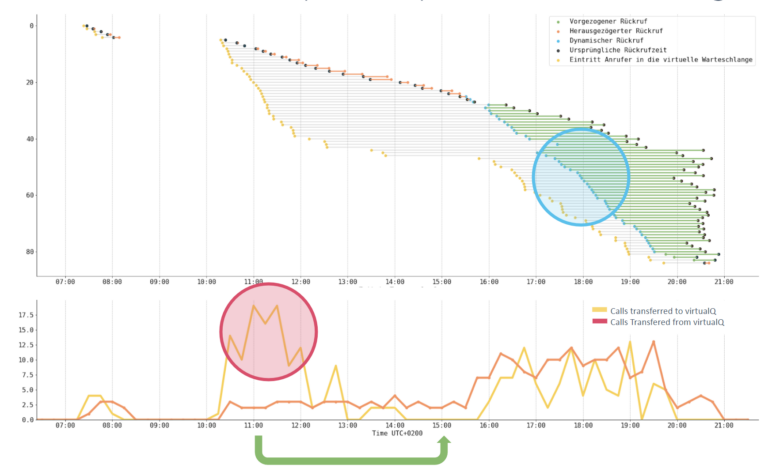
A virtual queue allows waiting customers to skip waiting on hold, and instead, opt in to be contacted again by a customer care agent when it’s the customers turn to be served. When a customer chooses this option, the virtual queuing system stores relevant contact details then waits until an agent is available, before automatically reaching out to the customer again and connecting him or her to an available agent. Depending on the type of virtual queue, the queuing system may take into account several conditions, e.g., current inbound call volume, before reconnecting the customer to the agent. Virtual queuing allows for customers to do something else while waiting in the queue offline, as opposed to having to stay alert and wait for an agent to begin speaking on the phone. This service is similar to offerings by brick-and-mortar stores and restaurants who send an SMS text or push-notification via app to customers when their table is ready, so that customers can quickly return to the restaurant to be seated.
PROS & CONS OF VIRTUAL QUEUEING
HOW CAN A VIRTUAL QUEUE HELP ME?
Allowing customers to forgo waiting on hold may increase customer satisfaction and reduce abandonment rate and repeat calls, as customers no longer need to wait on hold for an unspecified amount of time. This may also lead to higher employee satisfaction as well, since customers who haven’t had to wait are generally less frustrated than those who do. Some virtual queuing systems also allow for priority queueing, where your center can serve certain customers sooner, or multiple virtual queues so that customers with certain needs are served once a specialized agent is available. Virtual queueing can also help control large call volume periods by rescheduling calls to a lower call volume period. This in turn would also help distribute the workload more evenly to call center employees. Many call center managers wrestle with staffing questions, especially if the call center receives far more calls in the morning than in the afternoon, which means that additional employees to support morning peak periods are left with little work during non-peak hours. With virtual queuing, call center managers can make their centers more efficient by distributing calls more evenly throughout the day.
WHEN IS A VIRTUAL QUEUE NOT USEFUL?
Not all customer service centers benefit from having a virtual queue. For certain industries where customers need to be served right away, virtual queueing may not be an appropriate solution, unless a priority queue is available. In call centers where customers have simple questions they need answered or simple tasks performed, such as retrieving information from a database or giving an a approval for a payment or submitting non-invasive customer information, a virtual waiting service may not be the most efficient software tool to address these questions. Instead, automation bots may be better equipped to perform these tasks, so that customers do not need to speak with an actual agent.
WHAT TYPES OF VIRTUAL QUEUES ARE OUT THERE?
DEFAULT
Customers wait the same amount of time that they would have otherwise needed to wait if they were waiting on hold.
DATEBOOK-TYPE SCHEDULING SYSTEMS
Customers are given a choice of available time slots to be called back by the call center, and are given a call during the set appointed time. Call centers have a lot of flexibility in creating the number of time slots and the times available. This option might be useful to offer to customers after-hours, so that they can be called back during normal business hours, or to more evenly distribute calls throughout the day.
TIMER SCHEDULING SYSTEMS
Customers are called back after a set period of time passes. Customers know exactly when to anticipate when they will be called back, though one drawback is that if the call center is undergoing a high call volume, the influx of returning customers might exacerbate the bottleneck.
FORECAST-BASED SYSTEMS
Customers are called back during times that are of a lower call volume for the call center, allowing for the center to more evenly distribute the volume of calls throughout the day. One drawback to this is the customer may not know when they are called back, or the times that the customer is called back is not convenient for them.
HOW DO CUSTOMERS JOIN VIRTUAL QUEUES?
Customers can join virtual queues through multiple channels. A virtual queueing system can be provided through the following:
- Telephone or cell phone via customer support number
- Website: Webpage or Pop-up Forms
- Online Chat systems
- Mobile App
- Physical kiosks or tablets
IS VIRTUAL QUEUING RIGHT FOR MY INBOUND CONTACT CENTER?
Many inbound call centers wrestle with balancing the number of agents with the number of inbound calls, despite call volume forecasting and planning. This makes it challenging for centers to optimize staffing requirements, especially if the inbound center has an uneven call volume throughout the day. Virtual queuing can help call centers reduce the number of incoming calls that need to be answered by an agent, to make the call volume more manageable. Additionally, if an inbound call center is experiencing long wait times for their customers and a high abandonment rate because of said long wait times, it might also be worth looking into virtual queues, as they remove the need to wait for their customers. So, in conclusion, if you own an inbound call center with long wait times, or the number of agents isn’t quite balanced with the number of calls coming in, a virtual queuing system may be a good fit for you.











